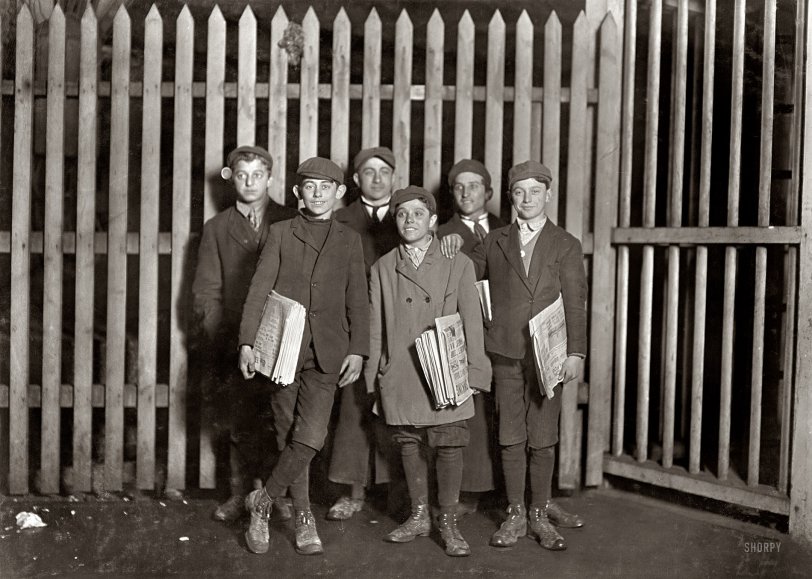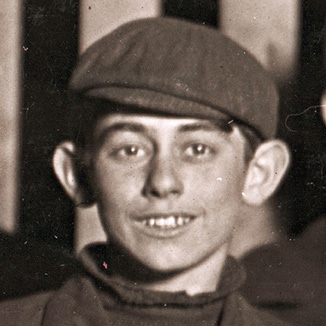


Framed or unframed, desk size to sofa size, printed by us in Arizona and Alabama since 2007. Explore now.
Shorpy is funded by you. Patreon contributors get an ad-free experience.
Learn more.

- Baldwin 62303
- Baldwin VO-1000
- Cold
- No expense spared
- Tough Guys
- Lost in Toyland
- And without gloves
- If I were a blindfolded time traveler
- Smoke Consumer Also Cooks
- Oh that stove!
- Possibly still there?
- What?!?
- $100 Reward
- Freeze Frame
- Texas Flyer wanted
- Just a Year Too Soon
- WWII -- Replacing men with women at the railroad crossing.
- Yes, Icing
- You kids drive me nuts!
- NOT An Easy Job
- I wonder
- Just add window boxes
- Icing Platform?
- Indiana Harbor Belt abides
- Freezing haze
- Corrections (for those who care)
- C&NW at Nelson
- Fallen Flags
- A dangerous job made worse
- Water Stop
Print Emporium
Maritime Mystery: 1909

March 1909. Bridgeport, Connecticut. "7 P.M. -- Boys selling papers at the depot. Smallest one has been selling for eight years." The headlines: We see the words SINKING and IN FOG. Photograph by Lewis Wickes Hine. View full size.
H.F. Dimock was prone to accidents
H.F. Dimock had a very checkered seagoing career with many accidents recorded; both groundings and sinkings (after which she was subsequently raised and repaired.)
Her name appears often in books about wrecks and collisions in the waters in and around New York during the early part of the 20th century.
Lewis Hine book out
I don't know if it's been mentioned, but there's a new biography of Lewis Hine out by Alison Nordstrom and Elizabeth McCausland. The BBC produced a piece on the book and Hine today, which can be seen here:
http://www.bbc.co.uk/news/magazine-17673213
Note: the article contains a video.
Growing
I'm not sure if the fella with the jug ears ever grew into them or later became known as "Kilroy". I'm wondering if the young man in the middle ever grew into his coat.
Why are they different?
The three in the front are wearing knickers, no neckties, and are holding newspapers; the three in the back are wearing long pants and neckties, and do not appear to have papers. While age is the difference, could it have been more than that? Did the older boys sell to a different customer, the riders, needing a more formal approach, while the youngers sold to the yard workers and such? Or was it first class vs coach?
Skeleton Coast
Partially covered headline ending in "TON" could be "Skeleton". On September 5th 1909 the Eduard Bohlen sank off the Skeleton Coast in a heavy fog.
Or I'm wrong.
[I suspect that's COLLISION, not "Skeleton." - Dave]
I bet it was the H.F. Dimock
She went down after colliding with the the steamer Horatio Hall in dense fog off Chatham, Mass., on March 10, 1909.
[It was the Horatio Hall that sank. The Dimock was beached. - Dave]
Horatio Hall
Google searching suggests it could it have been the Horatio Hall.
R.I.P. Horatio Hall
From the Cape Dive Club website:
Site Name: Horatio Hall
Type of Vessel: Passenger/Freighter
Dimensions: 296’ x 46’ x 17’ Tonnage: 3168
Built: 1898 Sank: March 10, 1909
Cause of Sinking: Collision with the H.F. Dimock Location: Pollock Rip
Summary: The Horatio Hall was carrying approximately 45 passengers and crew and a general cargo that included paper, sheepskins, potatoes, scrap brass, and cloth worth about $100,000. The Hall was traveling from Portland, Maine to New York City during heavy fog when the Dimock struck it. The Dimock collided into the port side of the Horatio Halls hull penetrating fifteen to twenty feet. The Dimock saw that it might be able to save passengers, so it continued to push the Hall towards the shoal and it allowed for the passengers to jump from the Hall to the Dimock to be rescued. There was no loss of life. Since the hurricane deck of the Hall remained above the water once the boat settled, much of the Hall was salvaged before it was cleared with explosives.
March 10, 1909
The H.F. Dimock collided with the Horatio Hall off of Cape Cod in dense fog. The Horatio Hall is a marked dive spot at Pollock Rip. More here.
Horatio Hall, H.F. Dimock
These newsboys were likely hawking their March 10, 1909 evening editions that were headlining the crash of the Horatio Hall and the H.F. Dimock in dense fog off the southeastern coast of Cape Cod,. The collision happened at 8 that morning and the Horatio Hall went to the bottom with no loss of life. Sources: Nashua Telegraph, March 10, 1909 and the Lewiston Journal, March 11, 1909
Mystery Solved?
Sounds like this could be a possible candidate for the sinking and fog incident:
New York Times, March 11, 1909
Ship Sunk In Crash,
The Other BeachedHoratio Hall and H.F. Dimock Collide
In the Fog Near Pollock RipCHATHAM, Mass., March 10 — Blanketed by a dense fog and proceeding at half speed, the coastwise steamer of the Maine Steamship Company, the Horatio Hall, Portland for New York, and the H. F. Dimock of the Metropolitan Line, New York for Boston, met in the middle of the narrow channel known as Pollock Rip Slue today with a crash that sent the Hall to the bottom within half an hour and caused the Dimock to run ashore six hours later on Cape Cod Beach, where the passengers and crew of the Hall were landed without loss of life.
Cape Cod Collision
Looks like it's this one :
http://www.capecodtoday.com/news/CC-History/2012/03/10/1909-
two-steamers-collide-in-pollock-rip
That Sinking Feeling
On March 10, 1909, the H.F. Dimock, bound from New York to Boston, and the coastwise steamer Horatio Hall of the Maine Steamship Company collided in the eastern Vineyard Sound shortly after 8 a.m. while sailing at half speed in a heavy fog. The accident occurred in Pollock Rip Slue, not far from where the H.F. Dimock had collided with the Alva in 1892. Captain John A. Thompson of the H.F. Dimock brough his vessel alongside the Horatio Hall so that the latter's five passengers could be transferred.
The Horatio Hall sank at the edge of the channel. Most of her crew left in lifeboats and were picked up by the H.F. Dimock, but Captain W. Frank Jewell, the pilot, first mate, and two seamen remained in the pilot house, which remained a few feet above water. (They were picked up later.) The H.F. Dimock left the scene at 11:15 a.m. and sailed slowly toward Orleans Life-Saving Station, where she was beached. The passengers and crew were removed by the lifesavers under Captain James H. Charles. Moderately damaged, the H.F. Dimock was later hauled off the beach and towed to shipyard for repairs.
Ship Sunk In Crash, The Other Beached
The headlines are reporting the collision of two coastal steamers off Cape Cod on March 10, 1909, in heavy early morning fog. Although one ship sank and the other was beached, no lives were lost. The New York Times ran the story on March 11. As for the chipper newsboy second from left, maybe he grew into those ears later on.

























On Shorpy:
Today’s Top 5